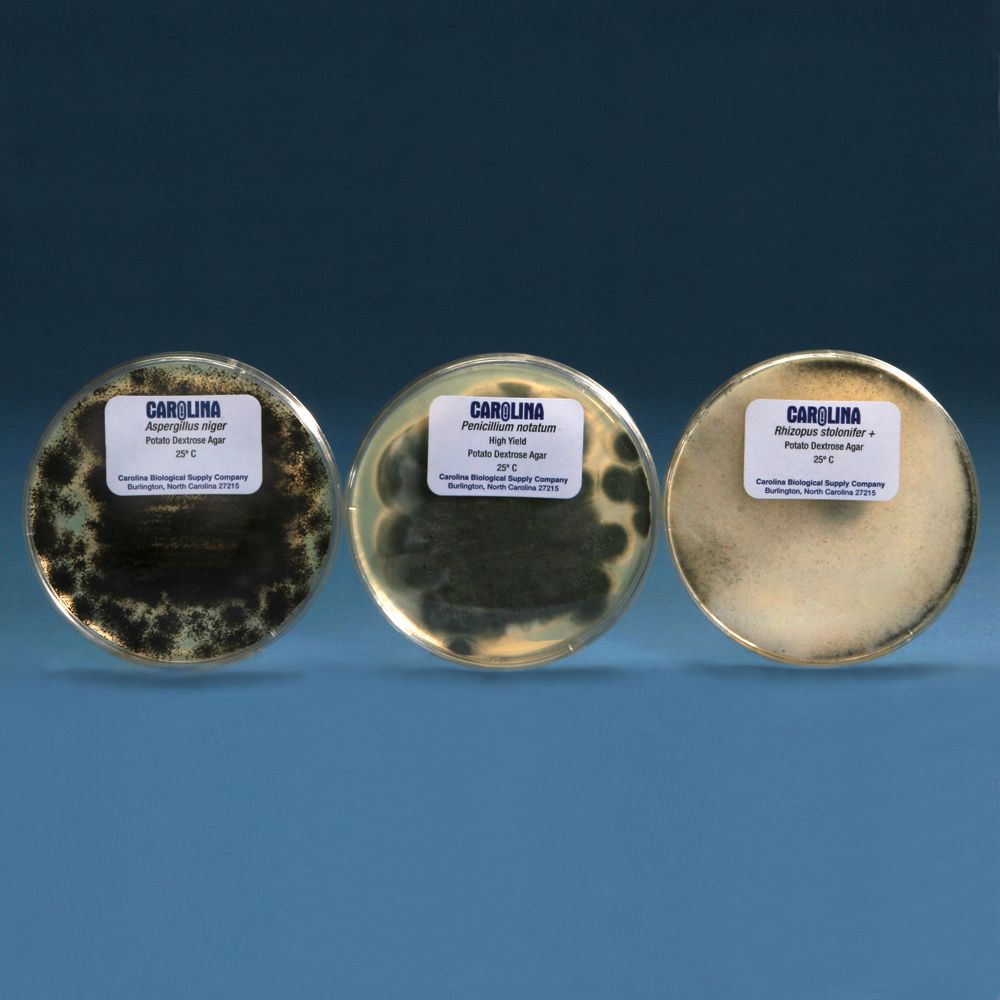My Cart
Your Shopping Cart is currently empty. Use Quick Order or Search to quickly add items to your order!

This introduction to fungi focuses on the production of asexual spores by three fungi: Aspergillus, Penicillium, and Rhizopus. Formerly Aspergillus and Penicillium were classified in a group called deuteromycetes (imperfect fungi) because the sexual stages, if any, of their life cycles were unknown. Currently, they are placed in the phylum Ascomycota (sac fungi), and their older classification has been abandoned. Rhizopus belongs to the phylum Zygomycota.
Basic Mold Showplate Set (155823)
Bunsen burners or alcohol lamps
stereomicroscopes (preferred) or hand lenses
beakers or cups for water
compound microscopes (preferably, with 40× option)
Optional Materials
You may substitute the following Student Independent Fungi Study Kits for the Basic Mold Showplate Set: 155779 Aspergillus niger Study Kit, 155780 Penicillium notatum Study Kit, and 155781 Rhizopus stolonifer Study Kit. Each of these study kits comes with a plate culture, a photomicrograph, information about the fungus, and a prepared microscope slide of the fungus.
This activity requires that students work with fungal cultures and open flames. All work surfaces must be wiped down with disinfectant before and after the lab. Have students wash their hands before and after the lab. Destroy any cultures remaining at the end of the lab by autoclaving or by flooding them with disinfectant overnight before proper disposal.
Ensure that students understand and adhere to safe laboratory practices when performing any activity in the classroom or lab. Demonstrate the protocol for correctly using the instruments and materials necessary to complete the activities, and emphasize the importance of proper usage. Use personal protective equipment such as safety glasses or goggles, gloves, and aprons when appropriate. Model proper laboratory safety practices for your students and require them to adhere to all laboratory safety rules.
Students may work individually or in pairs.
The plate cultures are usually ready to use upon receipt. To be certain, check them to verify that they are producing spores before using them in the activity. Although the cultures may be held at room temperature for up to 3 weeks after receipt, it is best to use them within 7 days. We do not recommend refrigeration of these cultures.
For each plate culture (Aspergillus, Penicillium, Rhizopus), set up a workstation with the following:
plate culture
stereomicroscope or hand lens
dissecting needle
Bunsen burner or alcohol lamp
dropping pipet in beaker of water
microscope slides
coverslips
Have students rotate among the workstations until they have prepared and viewed slides of each fungus.
Optional: If you are using the Student Independent Fungi Study Kits, have students view the prepared slides included in the kits. You may perform this lab in conjunction with our Introduction to Fungi LabSheet, which addresses the production of sexual spores by two representative fungi.
Observe your slide using the scanning and low-power lenses of a microscope. Look for the spores. Compare this slide of Penicillium with slides of Aspergillus and Rhizopus. Are the spores of Penicillium produced in a sporangium as are those of Rhizopus, or are they more like those of Aspergillus?
They are not produced in a sporangium and are more like the spores of Aspergillus.
Many mycologists (scientists who study fungi) use the term mitospore for the asexual spores of fungi. Why do you think they use that term (i.e., what does the term suggest)?
Asexual spores are produced by mitotic cell division, and the term mitospore refers to this.